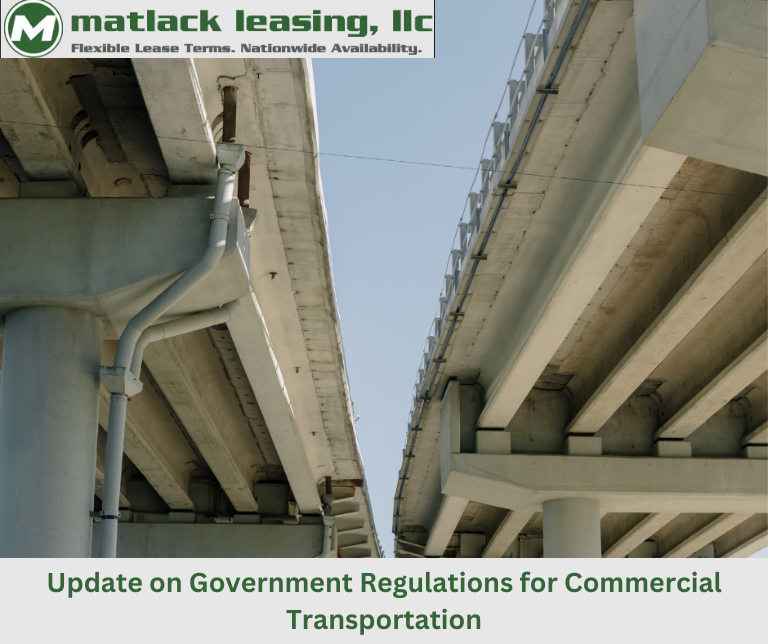Like any other year, 2023 brings with it new laws and regulations applicable to the commercial transportation industry. This year seems to hold an abundance of regulations with particular emphasis on transportation efficiency, emissions reduction, and safety concerns.
Infrastructure Act Improvements Scheduled for 2023
The Infrastructure Investment and Jobs Act (IIJA) is making a profound impact on United States’ infrastructure. According to Alec Lucas of Global X, $550 billion in new spending from IIJA is one of the largest domestic investments in U.S. history. California, Texas, and Florida are currently poised to receive the largest shares of the funding; however, benefits to every state will be in the billions.
The IIJA is intended to provide long-term investment into the country’s infrastructure. Much of the funding allocation is being provided through grant programs and 2023 promises funding for more and larger projects. Projects awarded this year should benefit the commercial transportation industry. For instance, the White House has reported that additional bridge and supply chain investments from the Bipartisan Infrastructure Law’s MEGA program for larger projects, including highway, bridge, freight, and port transportation projects shall move forward.
Safety Measurement Regulations
The commercial transportation industry is also discussing the way safety is measured and reported by the Federal Motor Carrier Safety Administration (FMCSA). In an effort to prevent and reduce crashes, the FMCSA has proposed changes to its Safety Management System (SMS). The SMS utilizes industry data for enforcement and to identify companies that require intervention or assistance in order to improve their safety record. FMCSA Administrator Robin Hutcheson stated, “Safety is the FMCSA’s core mission. The proposed changes are part of the agency’s continued commitment to enhancing the fairness, accuracy, and clarity of our prioritization system.” These changes include updating and reconfiguring existing SMS safety categories, organizing and prioritizing roadside violations, streamlining violation severity weights, and enhancing the identification process for intervention. The Compliance Safety Accountability (CSA) Prioritization Preview website now enables carriers to see how their data aligns with the proposed changes.
Motor carriers and other stakeholders may submit public comments about the proposed changes via regulations.gov. Comments are due by May 16, 2023.
The FMCSA’s Drug and Alcohol Clearinghouse is in the process of revamping its notification system and commercial transportation employers can now conduct free employment inquiries into drivers’ records. Later this year, the system expects to add the capability to notify fleets of updated driver record information such as failed drug tests. The FMCSA is also awaiting clarification from the Federal Department of Health and Human Services on the implementation of hair testing as a credible procedure in the Drug and Alcohol Clearinghouse. A ruling is expected later in the year.
The Department of Labor is also currently reviewing how owner-operator truck drivers are categorized by the federal government. Trucking organizations have been speaking out on the negative implications these regulations are likely to have on the industry.
EPA rules for Heavy Duty Engines
On December 20, 2022, EPA adopted a final rule which will significantly impact commercial transportation. In 2027, the “Control of Air Pollution from New Motor Vehicles: Heavy-DutyEngines and Vehicle Standards” rule will take effect. This regulation sets stricter emissions standards for new heavy duty engines in order to reduce ozone and particulate matter. It is the first step in President Biden’s Clean Trucks Plan. In an interview with FleetOwner, Richard Schweiter, General Counsel for the National Private Truck Council, stated that the manufacturer requirements could potentially increase the cost of diesel powered trucks by $42,000. The regulation also means vehicle manufacturers must move quickly to implement the technology needed to meet these requirements.
California CARB Rule
Commercial vehicle operators in California are subject to some of the most expensive and strict environmental regulations. These regulations originate from the California Air Resources Board (CARB). This year, CARB is bringing the following changes to the industry:
- Advanced Clean Truck (ACT) Regulation
- Advanced Clean Fleets Rule
- New TRU Regulations
Together, these regulations work to increase the number of zero emissions trucks on the road. Failure to comply with CARB regulations will be very costly; fines in California accrue daily. Several states have adopted CARB’s recommendations and more may do so in the near future. It is important for commercial transportation companies to align their fleets with current CARB standards.
For commercial transportation companies, knowledge of the latest regulatory changes is vital to success. At Matlack Leasing, we can meet your commercial transportation needs with our tank trailer and chassis leasing programs. Contact us today at www.matlackleasing.com or 1-800-MATLACK.
Sources
- “Fact Sheet: President Biden, Vice President Harris, Senior Administration Officials Kick off 2023 Implementing Bipartisan Infrastructure Law.” The White House, The United States Government, 4 Jan. 2023, 7 March 2023.
- Lucas, Alec. “Infrastructure Spending Update: Progress Continues as Companies Look to 2023.” Global X ETFs, 1 Mar. 2023, . Accessed 7 March 2023.
- “New, Pending, and Possible Rules and Regulations Facing Fleets in 2023 …” FleetOwner. 11 Jan. 2023,. Accessed 8 March 2023.


